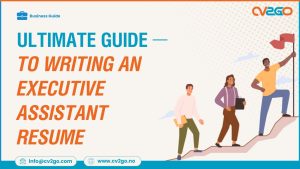Resumes should be concise—ideally no more than a page long—but you don’t want to leave out important information either. That’s why having the right resume structure is crucial.
Some resume headers are essential, while others waste valuable space. Let’s explore the must-have headers for your resume and the ones you should avoid. Plus, you’ll find helpful examples to use as a template.
Resume Headers You Should Include
Your Name
Don’t label your resume as “Resume”—the recruiter already knows what it is. Instead, make your full name the document title or first header. List your contact details directly underneath.
Tip: Include “resume” and your full name in the document file name, e.g., Jane_Doe_Resume_2024.pdf.
Professional Summary
Your professional summary provides a quick overview of who you are, why you’re applying, and what makes you a good choice. Use metrics and achievements to showcase your skills and experience. Incorporate key phrases from the job listing.
Example:
As a Shop Manager with three years of experience in a high-street store, I’m seeking a more challenging role in the luxury goods market. With a proven track record of boosting sales by 150% in 2024, I am a strong salesperson with excellent communication skills.
Skills
Use this section to detail the technical and soft skills that make you a good fit for the job. Reference the job listing and back up your skills with metrics and achievements. Aim for four to eight skills, each with its own bullet point.
Example:
- Written communication skills: Rewrote company landing page, leading to an 80% increase in sign-ups.
- Project management: Successfully led a team of 10 to complete a $500K project two weeks ahead of schedule.
When to Divide Your Skills Section
For some roles, it makes sense to divide your skills into two sections. For example:
- Translators might add a Languages section.
- Programmers might use a Programming Languages section.
- Graphic Designers might include a Software Proficiency section.
Ask yourself:
- Are these skills highly relevant to the role?
- Is there a clear distinction between the two types of skills?
- Are there enough of each type to justify two sections?
Work History
Also known as Career History or Professional Experience, this section details your past roles and responsibilities. Focus on recent and relevant positions.
What to Include:
- Job title
- Company name
- Start and end dates (month and year)
- Bullet points highlighting your responsibilities and achievements
Example:
Accountant, N&R Accountants, March 2020 — January 2024
- Worked on P&L statements, balance sheets, audits, and tax reports.
- Reduced clients’ annual tax bills by up to 17% by advising them on deductibles.
Education
If you have limited work experience, consider placing the education section above your work history. This is especially useful for new graduates or career changers.
What to Include:
- Degree and major
- School name
- Graduation year
- GPA (only if 3.5 or above)
Example:
Master of Arts in Corporate Communication, GPA: 3.9, 2024
The City University of New York
Bachelor of Arts in Communication and Media Studies, 2022
Fayetteville State University
Certifications and Licenses
If you have multiple certifications or licenses relevant to the job, create a separate section for them. If you only have one, include it in the Education or Skills section.
Affiliations and Memberships
For multiple relevant affiliations, create a dedicated section. Otherwise, mention them in your Professional Summary if they are significant.
Resume Headers to Leave Out
Contact Details Header
Your contact details are essential, but they don’t need a header. Simply list them below your name. Include:
- Phone number
- Email address
- Relevant links (e.g., portfolio, LinkedIn)
Tip: Skip your street address, date of birth, and photo.
References
Don’t include references or the phrase “References available upon request.” Recruiters will ask for references if they need them, so save the space for more important details.
Hobbies
Unless your hobbies demonstrate skills relevant to the job, leave them off your resume. If they are relevant, weave them into your Skills, Certifications, or Affiliations sections.
Internships and Volunteer Experience
Internships and volunteer roles provide valuable experience but don’t need a separate section. Include them in your Work History to highlight your professional experience.
Resume Header Templates That Impress Recruiters
You have just seconds to make a great first impression with your resume. Including the right headers ensures you present the most relevant information.
Why Use CV2Go?
Our resume builder helps you structure your resume based on your experience and qualifications. With over 2 million templates, you can:
- Quickly customize your resume for any job.
- Get recruiter-approved phrasing and skills suggestions.
- Ensure your resume is ATS-friendly and ready for digital scans.
Start building your perfect resume today and land that dream job!




